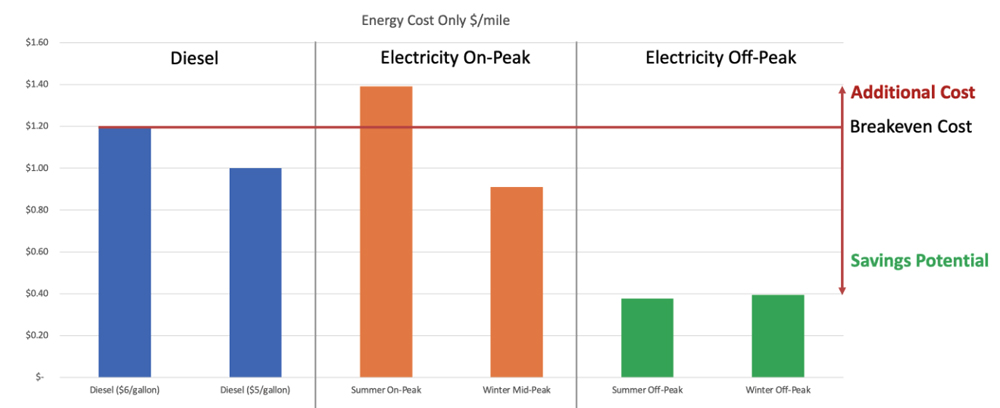
The Biden administration’s goal to achieve net zero emissions from transportation by 2050 will require an increase in the generation and delivery of an additional 1,800 terawatt-hours per year, estimates the Electric Power Research Institute.
Watson Collins, an engineer and senior technical executive at EPRI, offered the estimate Tuesday during a webinar organized by the North American Council for Freight Efficiency, a trucking industry initiative sponsored in cooperation with the Rocky Mountain Institute, an environmental organization.
“The grid today [carries] about 4,000 terawatt-hours,” Collins said, estimating the additional power needed to electrify transportation as roughly “about a 50% increase in throughput on the grid.”
“This is going to take 20 years,” he said, adding he’s not concerned since utilities made a similar increase in the past few decades to electrify heating, air conditioning and myriad other electrical functions.
In the meantime, Collins said trucking companies considering the cost of running electric trucks instead of diesels must keep in mind that “the slower you charge is better, [and] is cheaper. The infrastructure is less expensive. And it’s better for the batteries.”
 When an EV is charged is just as much a price determining factor as how much power the charge uses. | Electric Power Research Institute
When an EV is charged is just as much a price determining factor as how much power the charge uses. | Electric Power Research Institute
The faster a trucking company must charge its vehicles, the less likely those rigs will be cheaper to operate than traditional diesel vehicles, he explained, at least at today’s fuel and power prices. Slower charging during the night or off-peak hours during the day also will make the electric truck more cost-competitive compared to diesel, he added.
“There’s a huge savings potential if you’re charging the vehicles in the off-peak period. That’s part of why I’m mentioning that off-peak is usually the slow-charging, longer-duration charges, because you can save a lot of money.” Local utility infrastructure also is significant, he said.
An EPRI survey of utilities found that 60% would not have to immediately build costly and time-consuming upgrades to accommodate trucking company depots increasing their demand by no more than 1 MW.
By contrast, 60% of the utilities surveyed said they would need to build upgrades to handle a load increase of 20 MW, he said.
Robert Graff, a senior technical adviser at RMI and adviser to NACFE, said most commercial electric vehicles in use today are limited to 350 kW, “with many operations getting by with 50 kilowatts or less.”
“Charging at this level meets the needs of many fleets, particularly single-shift return-to-base operations.
“As the use of commercial battery electric vehicle expands … there will be use cases that will benefit from higher-power charging, such as adding hundreds of miles of range to heavy-duty trucking during around-the-clock operations,” he added.
Ted Bohn, an engineer with Argonne National Laboratory, said work now is concentrated on standardizing components and voltages. He said the lab has been experimenting with 350-kW units “tied in parallel to come up with 3,000 amps … at 1,000 volts and 300 amps.” That combination figures to 3 MW, he said.
By comparison, most home 240-volt EV chargers draw no more than 7,200 watts — less than 10 kW — according to the Department of Energy.
Emil Youssefzadeh, an engineer and chairman of WattEV, a California firm that leases Class 8 trucks and builds the charging stations to electrify them, said what his company has encountered is “a level of slowness” from utilities building upgrades to supply the company’s growing demand from the expansion of charging depots.
WattEV rents drayage trucks to companies working at the Port of Los Angeles, where diesel exhaust emissions had become a major problem.
But relying solely on a local utility for power may not always be necessary, Youssefzadeh said. “Is there a solution other than grid power? The answer is that we’re looking at different alternatives, putting in microgrids, solar with distributed energy resources, [to offer] higher capabilities, to go to 20 megawatts,” he said.
Ryan Menze, an engineer managing charging hardware and software engineering at Daimler Trucks North America, said the company has analyzed the situation in a process similar to balancing a series of mathematical equations.
“If any of these three things — technology, cost parity or infrastructure — is zero, we will not be successful as an industry. We will not be successful as an organization in pushing zero-emission technologies,” he said.
The company’s Freightliner division has designed a series of heavy-duty trucks marketed under the eCascadia model.
“From a technology perspective, on the vehicle side [of the equation], we need to ensure that we have the charging capabilities and can meet the range demands of our customers,” Menze said.
“One of the big technology analogies I like to use is [that] it’s kind of a balance. We need to have the right amount of charge speed which enables enough range and the time that our customers have using their 30-minute required breaks that they have to take every day and opportunity charging, when possible, but also having the necessary range on a single charge in order to complete their missions throughout the day,” he said.
The webinar was one of a series planned by NACFE and RMI in preparation for a three-week event in September designed to measure and record the charging, resilience and local distribution grid capacity at eight trucking depots operating fleets of at least 15 electric trucks. Seven of the depots are in California; the eighth is in Queens, N.Y.
The scrutiny of depot operations follows a similar series of real-world testing of trucking fleets by NACFE since 2016. (See DOE Offers $100M for Electrification of Heavy Trucks, US Way Behind China in Deploying Heavy-duty EVs,
Electric Trucking, from Delivery Vans to Big Rigs, are Coming, Report: Electric Heavy-duty Trucks Can Now Replace Some Diesels.)


